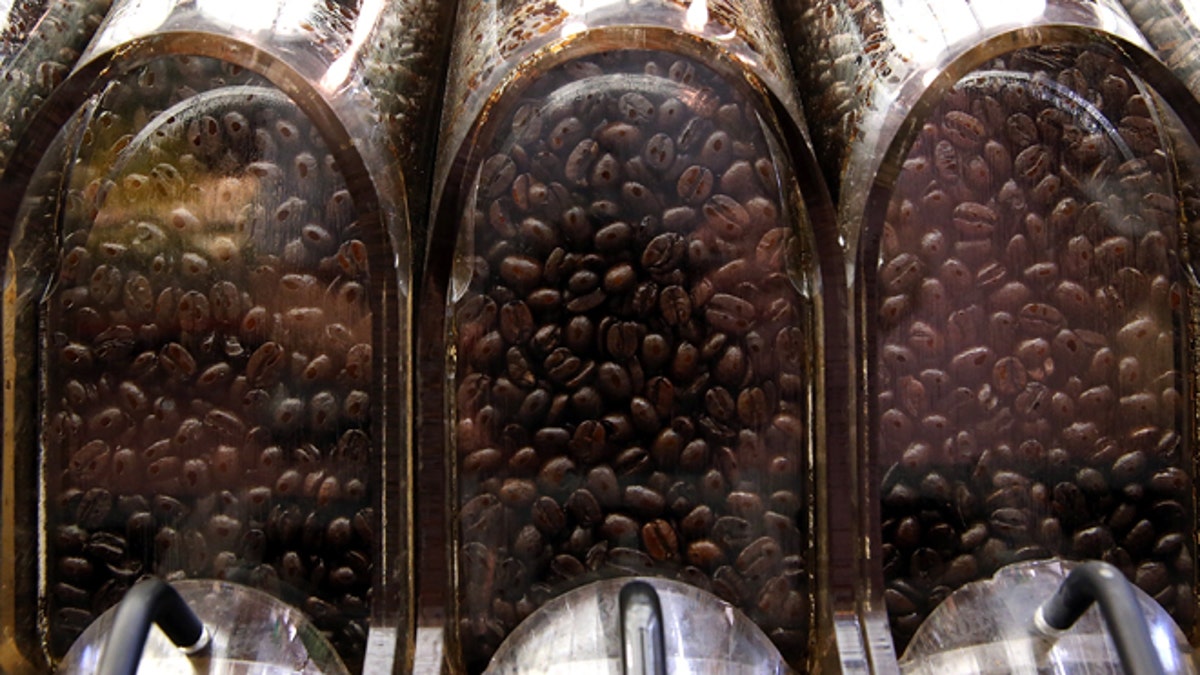
SAN FRANCISCO, CA - MARCH 27: Containers of bulk coffee beans are displayed at Cal-Mart Grocery on March 27, 2014 in San Francisco, California. Food prices are on the rise and expected to keep edging up throughout the year as the drought and other factors have impacted the availability and cost of groceries like coffee, milk, limes and pork. (Photo by Justin Sullivan/Getty Images) (2014 Getty Images)
Normally, the highlands of Central America are a perfect place to grow coffee.
One proof is that in Central America and southern Mexico, about four million people make their living from coffee, according to the Inter-American Development Bank. Half a million of those in Guatemala alone.
But a fungus called “La Roya” – rust – has been decimating the crops in practically every country in the region for more than a year. The fungus attacks the leaves of the plant, turning them a brownish-red color and starving them of nutrients.
According to the International Coffee Organization (ICO), coffee production in Costa Rica from April 2013 through March 2014 has fallen off by 9.08 percent over the same time frame the previous year.
And it’s the same story in the whole region: Salvadoran coffee production is down 12.7 percent, Nicaragua is down by 13.92 percent, and Honduras – the region’s largest producer – has been hammered with a 25.29 percent decrease.
The ICO has Guatemala’s decrease at just 3.48 percent, but according to the New York Times, the drop was 15 percent in 2013 alone.
This isn’t the first time that the region’s coffee plants have been affected by the fungus, but in years past only plants at lower elevations have been affected. Now, thanks to warmer weather and record rainfall, even the highest slopes are getting hit.
“The epidemic affecting the region [is] the worst seen since the pest first appeared in Central America in 1976,” a May 2013 ICO report said.
After years of low coffee prices, farmers in the region couldn’t afford to replace their old plants with new ones that are more resistant to the rust.
“There was nothing to hold it back because the farms were in very poor shape,” Maja Wallengreen, a coffee crop expert based in Mexico, told the Times. Even fungicides distributed by the government of Guatemala hasn’t stem the spread of the rust.
A fifth-generation coffee farmer in El Salvador, Aida Battle, told the Wall Street Journal that the rust resisted three fungicide sprayings on her farms. "It was just so aggressive," she said.
According to the Journal, the cost of some varieties of Central American coffee have gone up as much as 17 percent.
That increase is more likely to show up at your local fair trade coffee shop than it is in the supermarket, since a large percentage of the region’s coffee is harvested by small producers for the gourmet market. Even so, around 83 percent of the coffee grown in Central America is destined for the export market.
“The coffee here is positioned for its quality like the wines of France,” José Sebastián Marcucci, Guatemala’s vice minister of agriculture, told the Times.
A drought in Brazil, which grows about a third of all the coffee in the world, has driven the price of coffee futures to a 26-month high of $2.12/lb.
Not that that spike is noticeable yet in grocery stores. Ross Colbert, global beverage strategist at Rabobank in New York, told the Journal, "I don't think retailers and brand owners want to initiate price changes until there's a clearer picture on where prices are going to hold."
But it will happen. Colbert expects a 25 to 30 percent rise in retail prices by the middle of 2014. "I think we're likely to see it in increments," he said.
Any price increase won’t reach the Central American farmers any time soon.
“Roya has exposed the depth of the social and economic problems in terms of people’s vulnerability to the market and to climate change,” Peter Loach, the Guatemala director of the aid agency Mercy Corps, told the Times. “What makes it different and complicated is that it’s a slow-onset natural disaster over two to three years.”
The Guatemalan government is doing what it can, teaching small farmers how and when to prune and replace trees and to plant food crops between coffee plants to provide food while they mature.
One coffee farmer in Tzampetey, Guatemala, Servando Santos, told the Times that he kept the rust at bay with a combination of fungicide, fertilizer and providing shade cover for his plants.
“You have to adapt to the rust,” he said. “You have to make friends with it.”
Follow us on twitter.com/foxnewslatino
Like us at facebook.com/foxnewslatino
